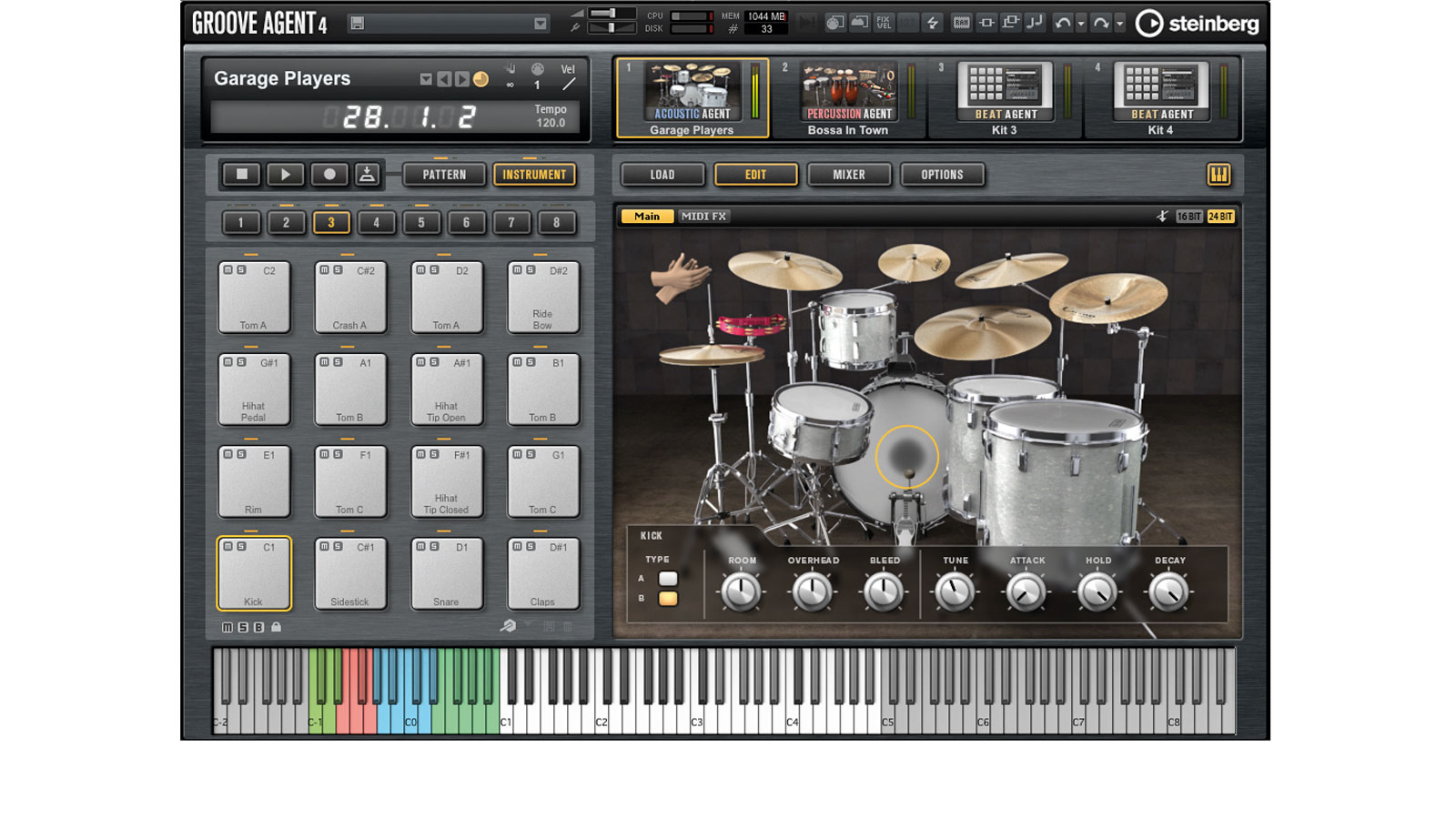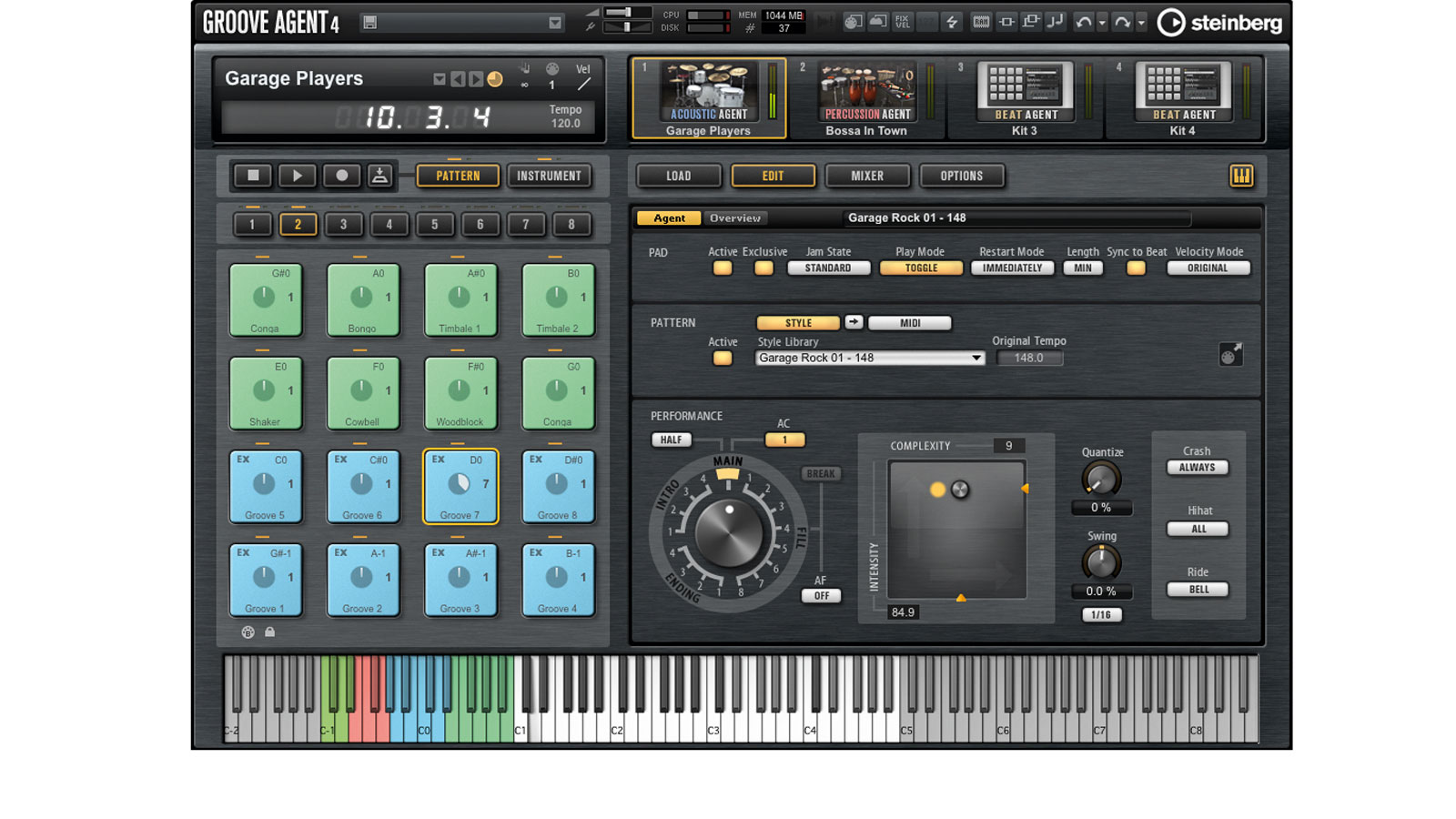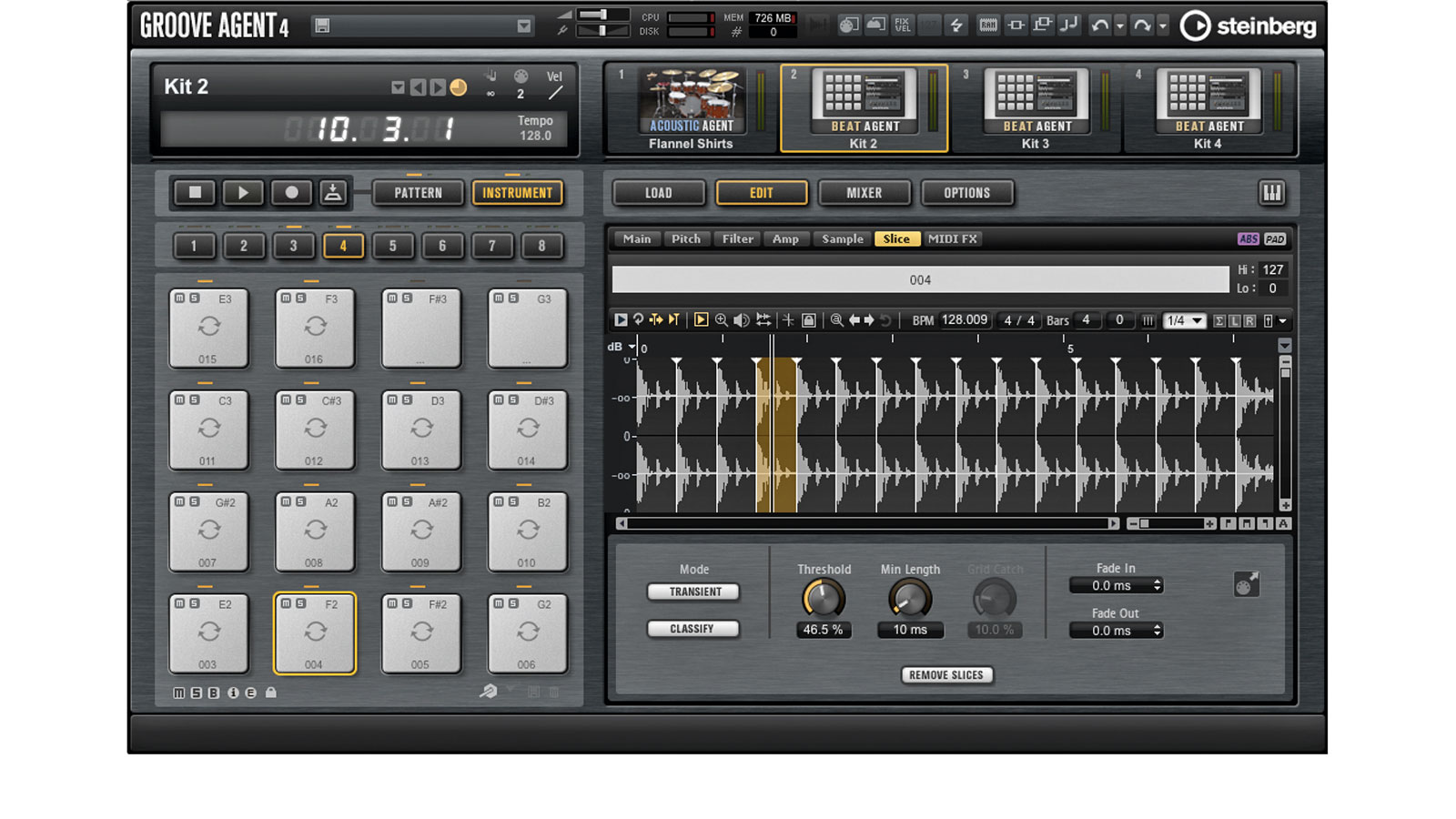MusicRadar Verdict
GA 4 is so well-improved they could have renamed it. It's an impressive, powerful and versatile solution for drum tracks of all kinds.
Pros
- +
Massive improvement over GA 3. Well-implemented acoustic kits. Excellent Beat Agent drum sampler. Good pattern library. Flexible pattern integration.
Cons
- -
Steep learning curve. Sound library could be more adventurous.
MusicRadar's got your back

Steinberg Groove Agent 4

Genres

Slice loops
Seven years ago, the third in Steinberg's long-running Groove Agent drum instrument series delivered a solid, creative, pattern-based experience, despite its rather clunky interface. With more than 22,000 all-new samples (7GB), over 3800 patterns and a totally rebuilt GUI, Groove Agent 4 (VST/AU/ Standalone) is essentially a completely new instrument altogether.
"What remains of the Groove Agents of old is that all-in-one rhythm machine ethos"
Rather than continuing the relatively inflexible 'virtual drummer' theme of earlier versions, GA 4 combines ready-made drum kit and percussion patches with a proper sampling engine and an extensive pattern library. The interface is far more contemporary and slick, and much more functional than before.
There are fancy playable drum kit graphics, proper drum machine Instrument Pads, Pattern Pads for triggering MIDI patterns mapped across the full range of 128 MIDI notes, an integrated Keyboard, MIDI Pattern recording, a drum grid Pattern Editor, and a full Mixer with four insert Effects per channel and four Auxiliaries.
However, what remains of the Groove Agents of old is that all-in-one rhythm machine ethos, whereby both sounds and patterns are loaded, edited and played back entirely within the instrument itself.
To that end, GA 4 includes three Instrument types (or Agents), named Acoustic (three kits), Percussion (20 kits) and Beat (100 kits), which can be freely assigned to the four available Kit slots.
Each Kit has its own Pattern section, and for the Acoustic and Percussion Agents this also incorporates Styles, which are rather like the feature of the same name from Groove Agent 3 (see Pattern o'clock).
Kit and caboodle
The acoustic kits offer a reasonable level of variety, with two snares and kicks each, plenty of velocity layers and round robin playback. For its open sound, the Vintage kit is our favourite, but all three will have their uses, the other two being tight and controlled (Studio), and bright with a couple of bold, ringy snare drums (Rock).
The Beat Agent kits lean towards urban and electronic styles, offering good starting palettes for tweaking and/or adding to. There are also a few useful 'soundtrack-style' presets, but little in the way of more leftfield or unusual ethnic sounds.
Meanwhile, Percussion Agent patches range from typical Latin styles to dance, pop, funk and soul, and include a good selection of crisp instrumentation, including timbales, congas, triangles, shakers and more.
"Steinberg cites Cubase integration as one of Groove Agent 4's marquee features"
Each Agent offers its own feature set. The Acoustic and Percussion Agents get a knob- laden Mixer with fixed insert effects (EQ, Compressor, Tape Saturation and Envelope Shaper), while Beat Agent's Mixer includes fully assignable effects for its four inserts (from a list of 29 processors). All Kits get four Auxiliaries with four effects slots each, however, as well as their own output channels feeding the Master output fader.
Editing of Acoustic and Percussion Agent's underlying sounds is limited to amplitude envelopes, tuning and send levels to their respective room and/or overhead channels. There's also no sample import.
However, these are precisely the areas in which Beat Agent excels, being essentially a conventional drum sampler hosting up to eight samples per pad, with adjustable velocity range and keyspan, three envelopes (pitch, filter and amplitude), real-time timestretch (AudioWarp), sample looping, sample slicing and MIDI effects (Rudiments and MIDI Delay).
Secret Agent
Steinberg cites Cubase integration as one of Groove Agent 4's marquee features. You can drag and drop MIDI Patterns to and from the DAW: dropping a single MIDI pattern onto a Pad replaces the incumbent one, while dropping multiple patterns arranges them across multiple Pads.
You can also drop samples into Beat Agent's Instrument Pads, and where you drop them within the Pad determines how they're handled: add (top), replace (middle) or map across multiple Pads (bottom). Beat Agent also imports REX files and slices loops in other formats, mapping them across multiple Pads.
As we discovered through testing GA 4 in Logic and Live, this drag-and-drop functionality works in other DAWs, too - although getting MIDI into Groove Agent required us to create MIDI files and drag them from the DAW's browser or Windows Explorer/OS X Finder.
Before we wrap up, let's quickly run through the less-fundamental new additions. Jam Mode lets you select Patterns sequentially in real time, setting them to follow certain behaviours, such as play Next, Stop at end and Return to previous.
The bit depth can be set to 16- or 24-bit independently for each Kit, which is useful when conserving memory usage. And finally, as the 128 Pattern Pads are shared across all four Kits, with, potentially, one Pattern from each Kit assigned to each Pad, there's a Pattern Overview screen to provide quick feedback on allocations.
Agent of change
Groove Agent 4 is a powerful drum sampler, virtual drum kit and percussion ROMpler with a huge library of patterns, capable real-time performance features, good onboard processing and a stylish, highly interactive interface, but there are a few issues that need to be raised.
The MediaBay Browser is great, but certain genres are notable by their absence (no jazz kits, for example). Let's hope further content becomes available in future.
Also, as much as we love the Acoustic Agent Kits, they offer less editing flexibility than you'll find in the best drum ROMplers. And there's no MIDI output, although we understand that it's due to be added soon.
In summary, Groove Agent 4 aims considerably higher than its predecessor, and succeeds in juggling the many requirements of a modern drum instrument, resulting in a powerful percussion production system that's more than just the sum of its parts.
Computer Music magazine is the world’s best selling publication dedicated solely to making great music with your Mac or PC computer. Each issue it brings its lucky readers the best in cutting-edge tutorials, need-to-know, expert software reviews and even all the tools you actually need to make great music today, courtesy of our legendary CM Plugin Suite.
“I feel like that song had everything we needed to come back with”: Bring Me The Horizon’s Lee Malia on Shadow Moses, its riff and the secrets behind its tone, and why it was the right anthem at the right time
“I said, ‘Are we sure we can write a song about death?’”: The story of Mike + The Mechanics' classic No.1 The Living Years
“Without investment in music education our talent pipeline is at risk of drying up along with the huge opportunities for economic growth it brings”: UK Music draws up five point plan to “turbocharge” music education










